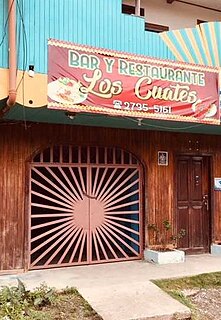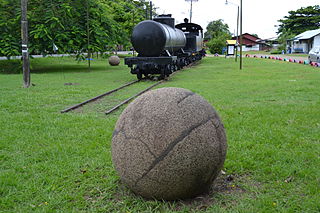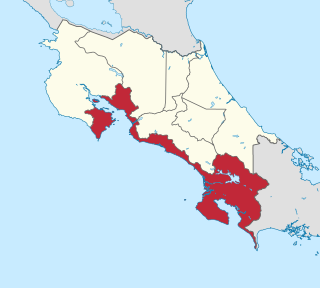
There are many modes of transport in Costa Rica but the country's infrastructure has suffered from a lack of maintenance and new investment. There is an extensive road system of more than 30,000 kilometers, although much of it is in disrepair; this also applies to ports, railways and water delivery systems. According to a 2016 U.S. government report, investment from China which attempted to improve the infrastructure found the "projects stalled by bureaucratic and legal concerns".

The stone spheresof Costa Rica are an assortment of over three hundred petrospheres in Costa Rica, located on the Diquís Delta and on Isla del Caño. Locally, they are known as Las Bolas. The spheres are commonly attributed to the extinct Diquis culture and are sometimes referred to as the Diquís Spheres. They are the best-known stone sculptures of the Isthmo-Colombian area. They are thought to have been placed in lines along the approach to the houses of chiefs, but their exact significance remains uncertain.
The 2006 UNCAF Interclub Cup was the 24th edition of the international club football competition held in the UNCAF region representing the seven nations of Central America. This was the eighth year of the current format using the name UNCAF Interclub Cup. The tournament was also a qualifying event for the 2007 CONCACAF Champions' Cup. Sixteen teams representing seven football associations took part, beginning with the first qualifying games on August 22, 2006. The tournament concluded with a two-legged final that was won by Puntarenas of Costa Rica making them the Central American club football champions. The top three finishers in the tournament qualify for the 2007 CONCACAF Champions' Cup.

The Osa Peninsula is a peninsula located in southwestern Costa Rica, in the Puntarenas Province, with the Pacific Ocean to the west and the Golfo Dulce to the east. The peninsula was formed geologically by a faulting system that extends north into California.

Dominical is a beach-front town in Bahía Ballena de Osa District in the province of Puntarenas in Costa Rica, approximately 45 km south of Quepos. It is well known for large, year-round waves and is popular among surfers in Costa Rica. The town began as a small fishing village but has since grown into a tourist attraction, most notably for surfers. Costa Rica Surf Camp
Marvin Obando Obando is a former Costa Rican football player who played most of his career for Herediano.

Palmar Sur Airport is an airport serving the adjacent towns of Palmar Norte and Palmar Sur in Osa Canton, Puntarenas Province, Costa Rica.

Puerto Jiménez is the largest town on the Osa Peninsula, Puntarenas Province, Costa Rica. The town is located on the Golfo Dulce near the Corcovado National Park. Also near the town is the Golfo Dulce Forest Reserve, where sightings of scarlet macaws, toucans and trogóns are common.

Buenos Aires is the third canton in the province of Puntarenas in Costa Rica. The canton covers an area of 2,384.22 km², and has a population of 48,706. Its capital city is also called Buenos Aires.

Puntarenas is the first canton in the province of Puntarenas in Costa Rica. The canton covers an area of 1,842.33 km², and has a population of 126,515. The provincial capital is the city of Puntarenas.

Osa is the fifth canton in the province of Puntarenas in Costa Rica. Located on Osa Peninsula, the canton covers an area of 1,930.24 km², and has a population of 29,892. Its capital city is Ciudad Cortés, formerly known as Puerto Cortés.
Térraba River, in the southern Brunca region of Costa Rica, is the largest river in that country.
The El Diquís Hydroelectric Project is an ICE hydroelectric dam project, currently in the planning stages, to be located between Buenos Aires, Osa, and Pérez Zeledón in Costa Rica. Planned as the largest hydroelectric dam in Central America, the El Diquís (Boruca/Veraguas) Hydroelectric Project will generate electricity for more than one million consumers, dwarfing the Pirrís hydroelectric plant which completed construction in January, 2011 and is set to begin producing electricity in September 2011. The project will require 7363.506 hectares of land, 915.59 hectares of which are indigenous territories, and displace 1547 people. It would also employ in the region of 3,500 people and the electricity produced has the potential to be exported to neighbouring countries.

Dieciocho Airport is an agricultural airport serving Finca Dieciocho and other oil palm plantations in Puntarenas Province, Costa Rica. The airport is 7 kilometres (4 mi) southeast of Palmar Sur and 1 kilometre (0.6 mi) off the Pan-American Highway. The runway lies alongside an unpaved field access road.

Nuevo Palmar Sur Airport is an airport serving the hamlets of Finca (farm) 10 and Finca 5 in Puntarenas Province, Costa Rica. The runway is 6 kilometres (4 mi) southwest of the town of Palmar Sur. There is distant mountainous terrain to the north.

Hurricane Nate was the costliest natural disaster in Costa Rican history. An unusually fast-moving tropical cyclone, it caused severe flooding in Central America, leading to widespread destruction and casualties, during early October 2017, before making landfall on the US Gulf Coast. The fourteenth named storm and ninth hurricane of the hyperactive 2017 Atlantic hurricane season, Nate originated from a broad area of low pressure over the southwestern Caribbean on October 3. The disturbance moved northwest, organizing into a tropical depression the next day and attaining tropical storm intensity early on October 5. The storm moved ashore the coastline of Nicaragua thereafter. Little change in strength occurred as the system continued into Honduras, and Nate began steady intensification over the warm waters of the northwestern Caribbean Sea shortly thereafter. It attained hurricane strength while moving through the Yucatán Channel early on October 7, attaining peak winds of 90 mph (150 km/h) in the central Gulf of Mexico later that day. Early on the next day, Nate made landfall near the mouth of the Mississippi River in Louisiana. After crossing the marshland of the Mississippi Delta, it made its second U.S. landfall near Biloxi, Mississippi early on October 8, causing a storm surge to flood the ground floor of coastal casinos and buildings, as well as causing rip currents, hurricane-force winds, and beach erosion.
Coto 47 is a city in the province of Puntarenas, Costa Rica. The city is located near the Costa Rica-Panama border.













